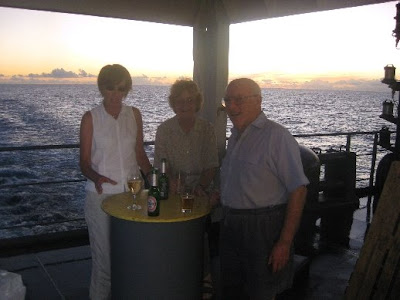Apologies to all of you who have been desperately waiting for the final instalment of the Blumsom Saga, but arriving home jet-lagged and dealing with all our possessions in the attic had to take priority.
Our journey across Mexico and the USA, leaving a trail of swine flu cases in our wake, only confirms our belief that we have been responsible for most of the disasters on the planet during the past 7 months. But once again we seem to have got out just in time.
We managed visits to four sets of friends in the USA - in San Diego, Buffallo, Portland (Maine) and Boston. Catching up with old friends, and staying just ahead of the flu, was everything we could have hoped for. We have to thank Joe and Rosa, Dan and Bonnie, Henry and Barbara and Shirley and Jack for this. American hospitality is always outstanding in our experience.
We had chosen to make our way across the states by rail. The Amtrak routes were really good and rather better quality than any of our previous rail journeys.
The Observation Car
Meals taken in the restaurant car were included in our tickets and we enjoyed meeting fellow travellers across the meal table. A couple of times the conversation started with “... and have you come far?” which was a tough one to answer.
The first journey from Los Angeles to Chicago took us through the mountains just south of the Grand Canyon. There were spectacular views from the observation car (which we failed to capture).
Going through the mountains
The train stopped in Albuquerque for an hour or so and we managed a walk through the town – sufficient to tell us that we didn't really need any longer.
Albuquerque
A shorter stop in Kansas City left us feeling that it would be interesting to spend more time there. The Union Station is quite magnificent and very much the station of the old Hollywood films.
Union Station in Kansas City
Crossing the Missouri River
We had a 5-hour wait in Chicago which was long enough to go up to the top of the Sears Building and walk to the lake. Chicago is very impressive. Seeing it all laid out before you from the top of the Sears Building – in glorious sunshine – is a remarkable experience.
View from the Sears Tower (1)
View from the Sears Tower (2)
We broke our journey in Buffallo, picking up the same train the next day. This gave us a chance to meet up with old friends. They took us to the Darwin Martin house which is one of Frank Lloyd Wright's designs – well worth seeing.
The Darwin Martin House, Buffallo
Our final Amtrak destination was Boston where we had booked a hotel for the night prior to picking up a hire car the next morning. We have always liked Boston. It has a slightly English feel to it. There is no longer any evidence of the 'Big Dig' in which they appeared to be digging road tunnels all over the city. It was coming to an end (after about 10 years) when we last visited about 6 years ago, and the city is so much better for the lack of building work.
The next morning we set off up the highway to Portland to see more old friends. Maine is simply beautiful and we had the benefit of glorious spring weather. During our two-day stay we talked for hours, visited the theatre, walked, and finally visited a store selling GPS equipment (Delorme) where they have a three-story model of the Earth. This is in the foyer of their store and the surface is made up from satellite pictures. I'm not sure how many times we pointed and exclaimed “we were there!” but it was enough.
The Giant Globe
Our final stop was in Westborough with Meg's cousin. Such very nice people and a wonderful way to end our journey.
The flight home was the low point of the whole 7 months. The de-humanising effect of passing through US security screening, the long wait for the flight, and then the discomfort of flying cattle-class over night is all something we would have preferred to have avoided. It was just unfortunate that our container ship from Montreal fell through.
Tom met us at the airport and delivered us to our house – which had been festooned with bunting and balloons. We were very touched.
Welcome Home
And now we have been home for just over a week and begun to acclimatise to the low temperatures.
It would be nice to be able to tell you what we have gained from it all but ideas are still evolving and settling. And don't ask us what the highlight of the trip was – the question is unanswerable!
We are certainly not the same people that left England on the 2nd of October. We are also aware that we have been very privileged to have been able to do what we have done (but know that it was no big deal in comparison with some of the adventures we have heard of). In seven months hardly a day passed without us seeing something remarkable although very few experiences can beat the glorious 'green' of Cirencester Park in spring.
Cirencester Park
The trip has reinforced our long-held view that people throughout the world are pretty nice, with decent values. The minority that don't fit this description is very, very small.
I think it might have got rid of the travel bug for a while – although Meg is off to Amsterdam and then Turkey in a couple of weeks for some work ...
For those of you who have managed to get this far, you might be interested in the sequel – “Meg and Jeff go to the Moon”.





































